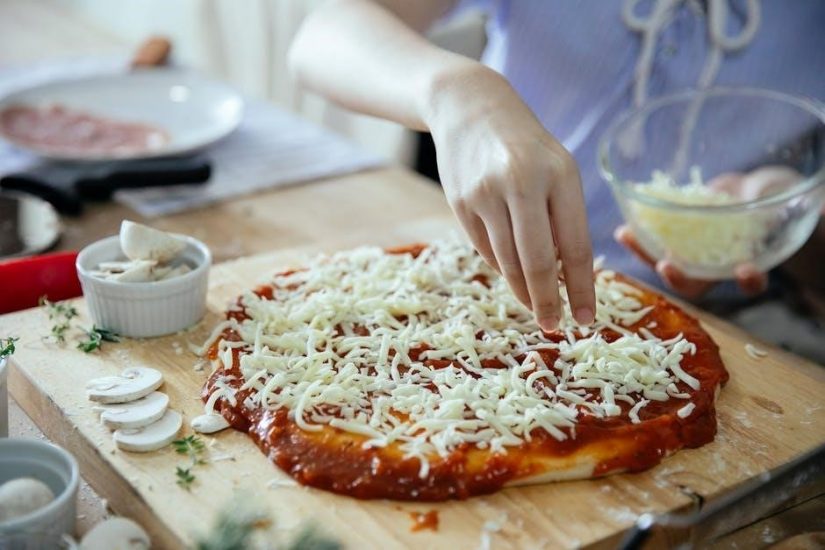Pizza cutting is an art that enhances the dining experience. Proper techniques ensure equal slices, prevent mess, and maintain flavor distribution, making every bite satisfying and enjoyable.
1.1 Importance of Proper Pizza Cutting Techniques
Proper pizza cutting techniques are essential for ensuring even portion distribution and a visually appealing presentation. Equal slices guarantee fairness, while clean cuts prevent toppings from shifting and cheese from stretching. This enhances the overall dining experience, making each bite consistent. Restaurants and pizzerias rely on precise cutting to maintain professionalism and customer satisfaction. Additionally, proper techniques prevent mess and make serving easier, especially in fast-paced environments. Mastering these skills elevates both homemade and professional pizza presentations, ensuring everyone enjoys a perfect slice.
1.2 Overview of Common Pizza Cutting Tools
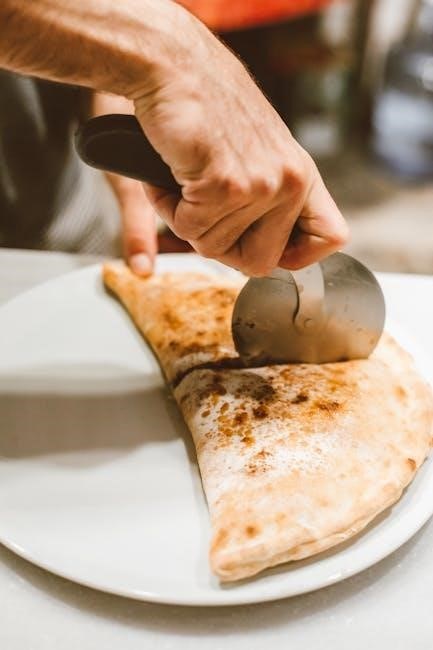
The right tools are crucial for achieving clean, precise pizza cuts. A pizza wheel is the most popular choice, offering a classic rolling cutter design that effortlessly slices through crusts. For thicker crusts, a chef’s knife or rocker blade provides more control and power. Kitchen shears are ideal for cutting uneven slices or portioning dough. A mezzaluna, with its curved blade, is perfect for detailed work. Each tool has its strengths, and choosing the right one ensures a professional finish. Using a cutting board or pizza stone as a stable surface further enhances the cutting process, making it safer and more efficient.
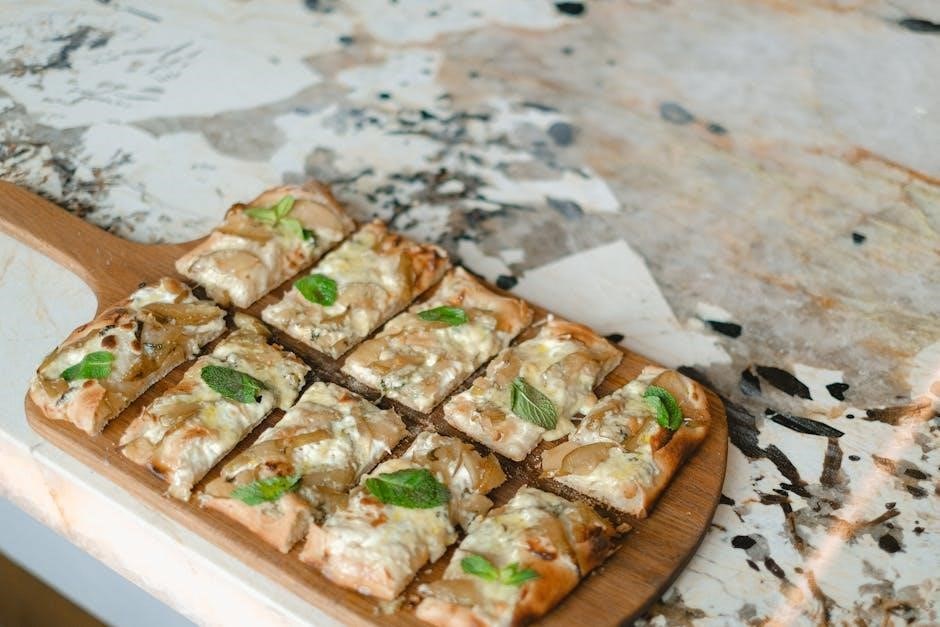
Essential Tools for Cutting Pizza
The essential tools for cutting pizza include a pizza wheel for clean slices, a chef’s knife for thick crusts, and kitchen shears for precision. Each tool offers unique advantages, ensuring perfect results every time.
2.1 Pizza Wheel (Rolling Cutter)
The pizza wheel, or rolling cutter, is a classic tool for slicing pizza. Its circular blade glides effortlessly through crust and toppings, making clean, even cuts. Lightweight and easy to maneuver, it’s ideal for both thin and thick crusts. For best results, preheat the tool to ensure smooth slicing. Gently roll it across the pizza, applying steady pressure. This method prevents toppings from shifting and ensures each slice is uniform. Using a pizza wheel enhances the presentation and overall enjoyment of your meal, making it a must-have for pizza enthusiasts.
2.2 Chef’s Knife and Rocker Blade
The Chef’s Knife and Rocker Blade are indispensable for precise pizza cutting. A Chef’s Knife offers versatility, making straight or diagonal cuts with ease, especially for thick crusts. The Rocker Blade, or mezzaluna, excels at controlled slicing, perfect for even cuts. Both tools require gentle pressure and a rocking motion, ensuring toppings stay intact. They allow for clean, uniform slices, enhancing presentation and dining experience, making them essential tools for any pizza enthusiast to master.
2.3 Kitchen Shears and Scissors
Kitchen shears and scissors are versatile tools for cutting pizza, offering precision and control. Shears are ideal for portioning slices evenly and handling thick crusts with ease. Scissors can be used to cut dough or toppings before baking, ensuring a clean finish. For effective use, place the pizza on a stable surface and cut slowly, applying gentle pressure. Shears are particularly useful for cutting fresh toppings post-bake. Always clean tools thoroughly after use to prevent residue buildup. These tools provide a practical alternative to traditional cutters, making them a must-have for pizza enthusiasts seeking versatility in their cutting techniques.
Basic Pizza Cutting Techniques
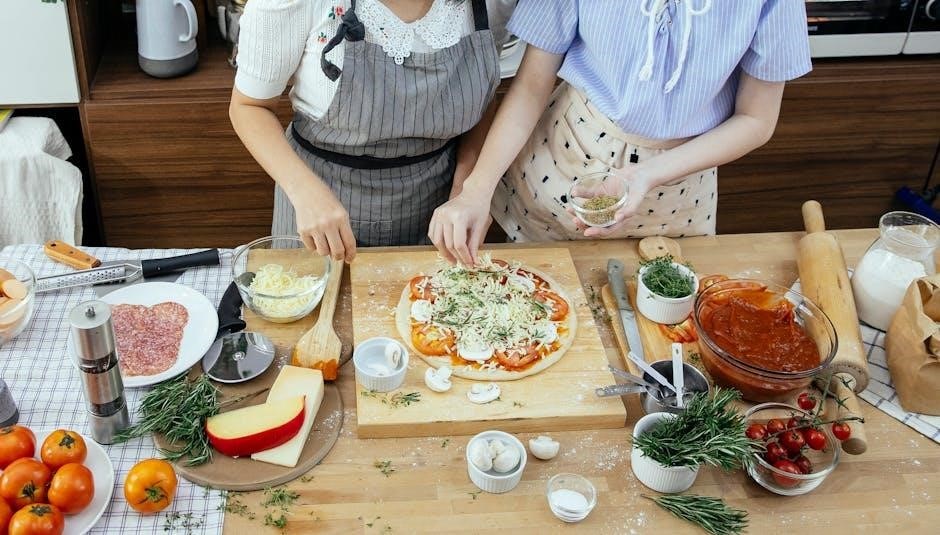
Mastering fundamental techniques like triangle cuts, square slices, and strip portions ensures even distribution. Start by cutting from the center, using a steady hand for perfect results every time.
3.1 Traditional Triangle Cuts
The traditional triangle cut is a classic method for dividing round pizzas. Start by positioning the pizza on a stable surface, such as a cutting board or pizza stone. Using a pizza cutter or sharp knife, make a straight cut from the top edge to the bottom crust, dividing the pizza into two equal halves. Continue by rotating the pizza and cutting each half into smaller triangular slices. For even distribution, ensure each cut is symmetrical and evenly spaced. This technique is ideal for round pizzas and creates uniform slices that are easy to serve and enjoy. It’s a timeless approach favored for its simplicity and effectiveness.
3.2 Square and Strip Cuts
Square and strip cuts offer versatility for rectangular or square pizzas. For square cuts, divide the pizza into equal-sized squares by making parallel vertical and horizontal cuts. This method is ideal for thick-crust pizzas like Sicilian style. Strip cuts involve slicing the pizza into long, narrow strips, which can then be cut into smaller, bite-sized pieces. Both techniques ensure even portioning and are visually appealing. Using a chef’s knife or pizza cutter, apply gentle pressure and maintain straight lines for clean cuts. These methods are perfect for casual gatherings or events, providing easy-to-handle slices that suit a variety of toppings and crust types.
3.3 Achieving Equal Slices
Achieving equal pizza slices ensures fairness and satisfaction for everyone. Start by placing the pizza on a stable surface and using a pie cutting guide for precision. Divide the pizza into halves, then cut one half into thirds and the other into fourths for almost equal portions. For even distribution, mark the pizza’s center and make radial cuts at equal angles. Cooling the pizza slightly before cutting helps prevent cheese from stretching unevenly. Using a sharp tool, like a pizza wheel or chef’s knife, ensures clean cuts. This method guarantees consistent sizes and a visually appealing presentation, making it ideal for gatherings and events where equal sharing is key.
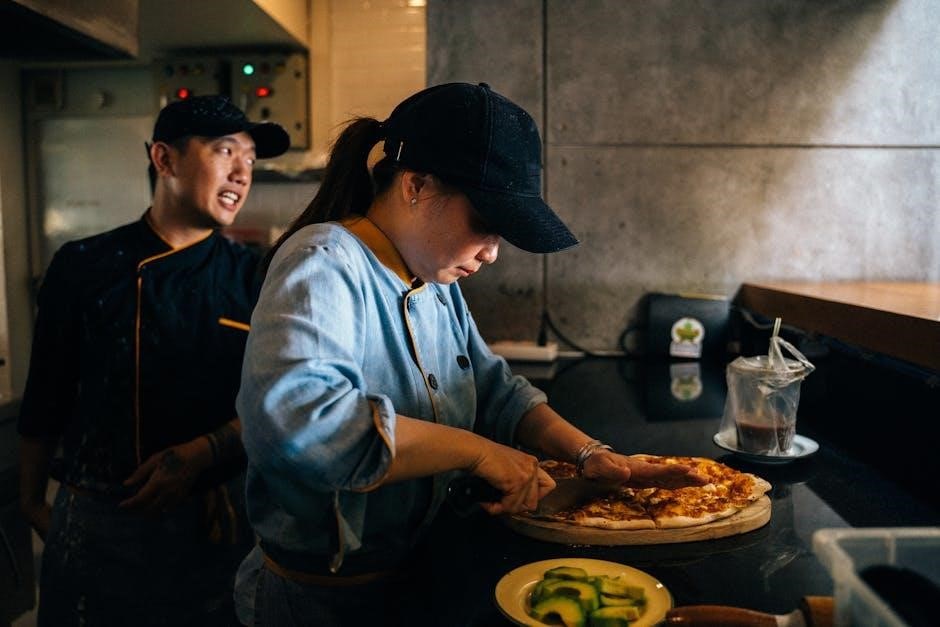
Advanced Cutting Methods
Advanced techniques involve precision tools like pie guides for uniform slices, methods for uneven cuts, and specialized strategies for thick crusts, enhancing both presentation and flavor distribution.
4.1 Using a Pie Cutting Guide
A pie cutting guide is a valuable tool for achieving uniform slices. It helps mark equal sections, ensuring fairness and consistency. Place the guide on the pizza, align it with the center, and use a knife or cutter along the marked lines. This method is especially useful for large gatherings or when precise portion control is needed. Guides often feature adjustable markings, accommodating different slice numbers and sizes. By minimizing uneven cuts, a pie guide enhances presentation and satisfaction, making it a must-have for hosting pizza nights or events. It simplifies the process, guaranteeing perfect results every time.
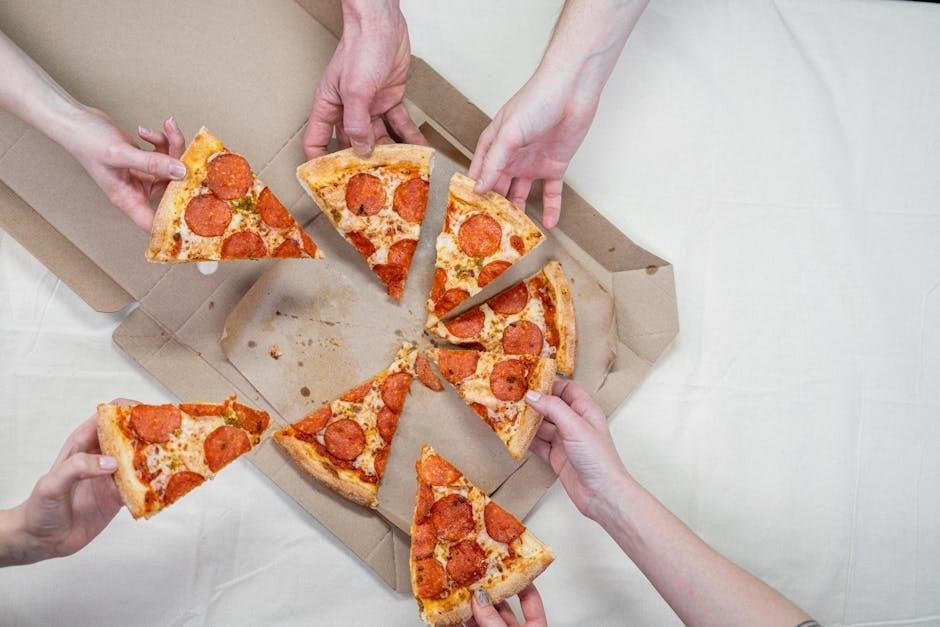
4.2 Cutting Uneven Slices
Cutting uneven slices allows for creativity and flexibility, catering to different preferences or appetites. Start by making a few radial cuts from the center, then adjust the position of subsequent cuts to create slices of varying sizes; For example, one large “winner’s slice” can be paired with smaller slices for others. This technique ensures everyone gets a fair share while accommodating individual needs. Uneven slicing is ideal for casual gatherings or families with differing eating habits. With practice, you can master this method, achieving a balance between variety and portion control. It’s a practical approach for enhancing the pizza-sharing experience.
4.3 Special Techniques for Thick Crusts
Cutting thick-crust pizzas requires specific techniques to avoid breaking the crust or creating uneven slices. Use a serrated knife or pizza rocker for clean cuts, as these tools handle dense dough effectively. Apply gentle pressure to prevent crushing the crust, and start by cutting from the center outward. For extra stability, let the pizza cool slightly before slicing. To minimize crumbling, make initial cuts on the softer side of the crust. Using a pie cutting guide can help achieve even portions. Additionally, a preheated pizza cutter can glide through thick crusts more smoothly, ensuring precise and neat slices every time.
Mastery of pizza cutting enhances the entire dining experience, ensuring perfect slices and satisfaction for everyone. Proper techniques and tools make every pizza a delightful, evenly shared meal.
5.1 Mastering the Art of Pizza Cutting
Mastery of pizza cutting involves precision, the right tools, and practice. Using a pizza cutter with gentle pressure ensures clean slices, while a knife requires a steady sawing motion. Proper techniques like triangle cuts or square slices enhance presentation and portion control. Allowing the pizza to rest before cutting prevents toppings from shifting, ensuring even distribution. Exploring tools like a pizza wheel or rocker blade can elevate your skills. Achieving equal slices is key for fairness and satisfaction. With patience and experience, anyone can master the art, transforming pizza cutting into a seamless, enjoyable process that complements any meal.
